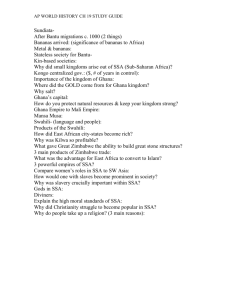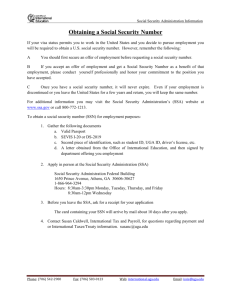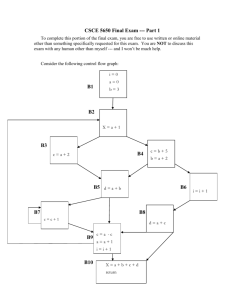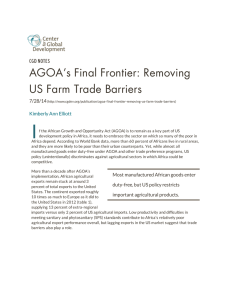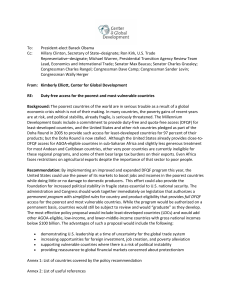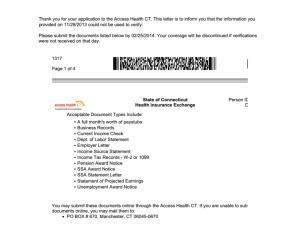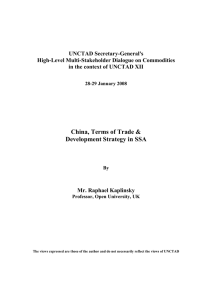Does a Unilateral Policy Change Promote Trade? Bedassa Tadesse
advertisement
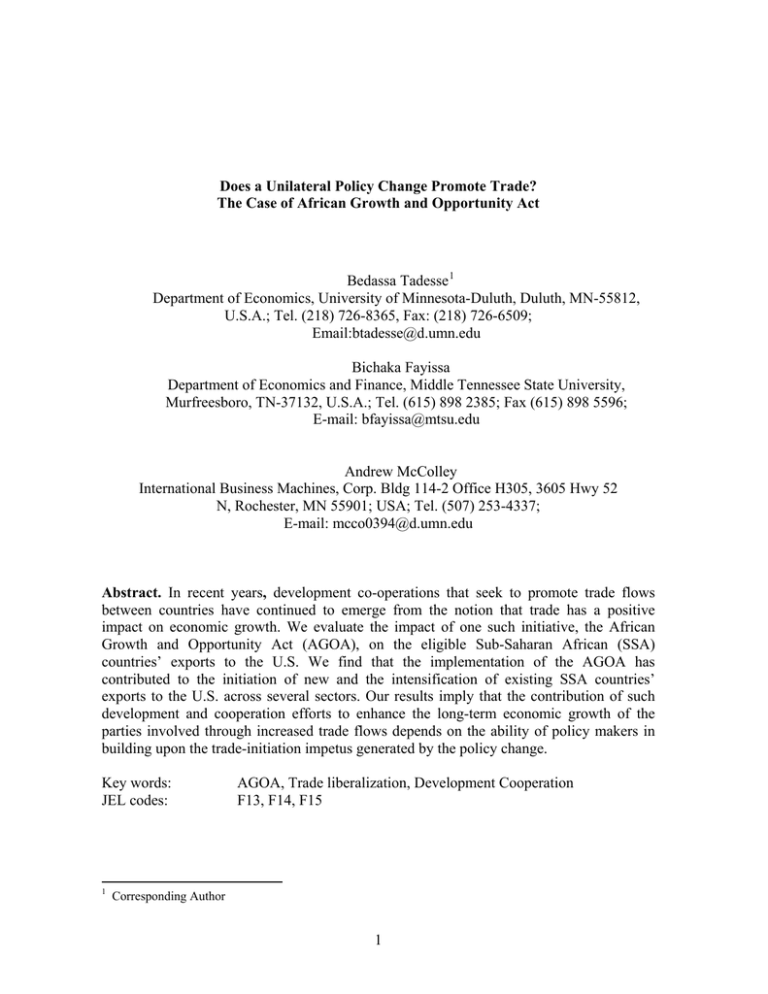
Does a Unilateral Policy Change Promote Trade? The Case of African Growth and Opportunity Act Bedassa Tadesse 1 Department of Economics, University of Minnesota-Duluth, Duluth, MN-55812, U.S.A.; Tel. (218) 726-8365, Fax: (218) 726-6509; Email:btadesse@d.umn.edu Bichaka Fayissa Department of Economics and Finance, Middle Tennessee State University, Murfreesboro, TN-37132, U.S.A.; Tel. (615) 898 2385; Fax (615) 898 5596; E-mail: bfayissa@mtsu.edu Andrew McColley International Business Machines, Corp. Bldg 114-2 Office H305, 3605 Hwy 52 N, Rochester, MN 55901; USA; Tel. (507) 253-4337; E-mail: mcco0394@d.umn.edu Abstract. In recent years, development co-operations that seek to promote trade flows between countries have continued to emerge from the notion that trade has a positive impact on economic growth. We evaluate the impact of one such initiative, the African Growth and Opportunity Act (AGOA), on the eligible Sub-Saharan African (SSA) countries’ exports to the U.S. We find that the implementation of the AGOA has contributed to the initiation of new and the intensification of existing SSA countries’ exports to the U.S. across several sectors. Our results imply that the contribution of such development and cooperation efforts to enhance the long-term economic growth of the parties involved through increased trade flows depends on the ability of policy makers in building upon the trade-initiation impetus generated by the policy change. Key words: JEL codes: 1 AGOA, Trade liberalization, Development Cooperation F13, F14, F15 Corresponding Author 1 I. Introduction The impact of trade on the economic growth and development of nations is well documented in the literature. Different development cooperation efforts that sought to promote trade flows between commerce partners have thus continued to emerge. The African Growth and Opportunity Act (AGOA), a U.S. unilateral trade policy concession toward Sub-Saharan African countries, is one such example. This paper investigates the impact of the implementation of the Act on the level of AGOA eligible sub-Saharan African (SSA) countries’ exports to the United States. AGOA was signed into the U.S. laws on May 18, 2000. The Act provides the eligible SSA countries duty-and quota-free export access to the U.S. markets, a tangible incentive for African countries to continue to open their economies and build free markets. As of June 2007, thirty-eight SSA countries are declared eligible for benefits under the programme. Since October 2000, AGOA has on several occasions extended the list of products and countries that are eligible for benefits under the Act. 2 While the products eligible for duty free access to the U.S. markets under AGOA, among others include textiles, footwear, luggage, handbags, watches, and flatware, the expiration date for benefits under the programme has already been extended twice and is currently set to 2015. The Act authorizes the President to remove countries and/or products from the list if they are not making progress toward the conditions stipulated, or if there are import surges that are causing or threatening to cause damage to the U.S. industry (USDOC, 2007). 2 Before AGOA, approximately 4600 products were duty free under General System of Preferences (GSP) and AGOA has extended that list by approximately 1800 items. 2 As an integral part of development cooperation, free trade agreements are historically expected to increase trade flows among trading partners and, thereby, enhance economic growth. Carrere (2004), Romalis (2003), and Gould (1998), for example, document that the removal of tariffs on several items in the U.S., Japan, Europe, and Canada has increased trade flows in the order of 11 percent. Proponents of AGOA thus argue that by expanding preferential export access to over 2000 different products originating from SSA countries to the U.S. markets, AGOA has the potential to increase trade flows between the U.S. and SSA countries and, thereby, enhance the long-term economic development of the eligible countries. To this end, Ianchovichina et al. (2001) speculate a roughly 14 percent increase in SSA exports if granted a preferential market access to the European Union, Japan, U.S., and Canada. Critics of AGOA, on the other hand, question the potential benefits of the initiative for SSA countries by arguing that African exports to U.S. are either concentrated in a few countries or dominated by petroleum products, a sector that has relatively low value added (Nouve and Staatz, 2003). Milner et al. (2000) cite transport costs as major constraint to African trade in general, while Lindsey (2002) maintains that U.S. and OECD countries’ trade policy initiatives often have mixed signals. A cursory review of the available U.S.-AGOA eligible SSA countries’ trade data, on the other hand, indicates a rise in U.S. imports from an average annual pre-AGOA value of $3,114,985 to $4,558,170 (46.3%) post-AGOA for non-manufactured goods and $631,128 to $1,454,334 (130.4%) for manufactured goods. However, whether these changes are the result of the development cooperation initiated as a unilateral trade policy concession, or the inertia in the eligible SSA countries’ global trade pattern, or changes in 3 other economic policies of the eligible SSA countries, or combination of these factors is not obvious. In this study, we use both aggregate and disaggregated SITC-1 digit level and Harmonized System (HS-2) level AGOA eligible SSA countries’ exports to the U.S. during 1991-2006, control for key determinants of trade flow, and investigate if the changes in the volume of SSA countries’ exports to the U.S. can be attributed to the implementation of AGOA. In doing so, we also separate the trade-initiation effect of the implementation of the act from its trade-intensification effect. Our work thus contributes to the literature on development cooperation by providing empirical evidence on the impact that a unilateral trade policy initiative has on the volume of trade flows while separating the impact into trade-initiation and -intensification effects. The remainder of the paper is organized as follows. Section II presents the analytical framework, explanatory variables, data, and the empirical model. Results are presented and discussed in section III. Section IV draws conclusions and makes some policy recommendations based on the results. II. The Theoretical Framework, Empirical Model, and Data 2.1. The Theoretical and Empirical Model We employ the widely used gravity model that specifies the volume of trade flows between countries as a function of their respective incomes and geographic distance. We adopt a theoretical gravity model derived by Anderson (1979). In its basic form, the model ⎛ ~ ⎞ posits that country i’s exports to country j ⎜ X ij ⎟ increase with the trading partners’ ⎝ ⎠ combined economic mass and decreases with the geodesic distance between the trading partners. Economic mass is given as the product of the gross domestic products of the 4 exporting state (Yi ) and that of the importing country (Y j ) , while the geographic distance (GD ) between the capital cities of the trading partners serves as a proxy for transportation ij costs. Using Λ as the constant of proportionality, equation (1) below illustrates this relationship. ( X ijtM = Λ Yit Y jt ( Dij ) −1 ) (1) Augmenting the basic gravity model in equation (1) with a vector Z containing sets of trade-inhibiting and trade-facilitating variables including AGOA to control for additional factors that influence trade flows, we can express the above relationship as follows: X M ijt = Yi β1 Y jβ 2 GDijβ 3 ( exp Z ij λ (2) ) Respectively, equation (2) postulates positive and negative effects of the incomes of the trading partners and the geographic distance (transportation cost) between them. It also strictly predicts a positive realization of imports, or exports. However, when dis- aggregated, trade data often contain numerous cases of zero imports or exports. Thus, following Eaton and Tamura (1994) and Head and Ries (1998), we modify equation (2) to obtain a specification that allows for the realization of zero trade values. ~ X ij = Λ Yi β1 Y jβ 2 GDijβ 3 (( ) exp Z ij λ + ξ ijt − η 5 ) (3) Where ξ ijt is an assumed identically and independently distributed error term and η is the fixed amount of trade that is subtracted from the level predicted by equation (2). Hence, an observed export of product m from AGOA eligible nation i to the U.S. will be set to zero when the latent export value is negative. Thus, observed data on each nation’s exports to ⎡~ ⎤ the U.S. can be described as X ij = max ⎢ X ij , 0⎥ . ⎣ ⎦ 2.2. The Empirical Model, Variables, and Data Substituting the identity in Equation (3), further rearranging the resulting expression, expanding the explanatory variables included in the vector Z ij , and taking the natural logarithms of the continuous variables where appropriate results in our estimation equation (4) below: ln X ijtM = β 0 + β1 ln DISTij + β 2 ln GDPjt + β 3 ln GDPit + β 4 ln POPit + β 5 ln POPjt + β 6 ln IMMijt + β 7 ln GDEFit + β 8 ln GDEFjt + β 9 ln EXRTijt + β10 ENGi + β11 LLCK j + β 12YXPi + β 13 ln IRM ijt + β 14 AGOAit + β 15 X ijtM−1 + ξ ijt (4) Where ln is the natural logarithm, i is the exporter (SSA country), j is the importer country (USA), t is the year, DIST is the distance from the capital of each SSA country i to New York (measured in Kilometres using the great circle method), and GDP and POP refer to the gross domestic product and the population size of each country as expressed in the theoretical gravity model. X ijtM and denotes each SSA country’s exports of aggregate, 6 Manufactured or Non-Manufactured goods and the SITC-1 digit, or selected HS-2 digit level products M, while X ijtM−1 denotes a one year lagged values of exports used as a dependent variable. We include a one-year lag of the dependent variable following Eichengreen and Irwin (1996) to capture the inertia effect of the previous level of U.S. imports from each SSA country. Following Gould (1994), we also control for the relative domestic price levels of each SSA country by using their respective GDP deflators ( GDEF ). To capture the potential effects of each country’s terms of trade with the U.S., we also include EXRT . Expressed as a change in each SSA country’s currency unit per U.S. dollar, an increase in the value of this index indicates increased depreciation of country i’s currency against the U.S. dollar and is thus expected to increase U.S. imports from each country. Prior studies have established that immigrants exert positive influences on trade via three separate, but related sources: (i) their preferences for certain goods, especially when they fail to find desired home country products or acceptable substitutes available (Globerman, 2001), (ii) their knowledge of political or social obligations required to conduct business in their home countries, which if used effectively may reduce transaction costs, convey otherwise unknown information regarding trading opportunities (Dunlevy and Hutchinson, 1999, and Head and Ries, 1998), and (iii) their connections to business or social networks which help deter opportunistic behaviour, thus increasing their host’s imports/exports from/to their home countries (Rauch and Trindade, 2002). Thus, we augment the model with the stock of immigrant population ( IMM ) from each SSA country. 7 Since each country’s trade with the U.S. may also depend on the outside (i.e. nonU.S.) trading opportunities available to each SSA country, we include an inverse of a K measure of economic remoteness in our model. Expressed as IRM jt = ∑ [(Yit / Ywt ) / Dik ], i =1 the variable is a measure of an inverse of the quasi-distance described in Wagner et al. (2002), where Dik is the distance between each SSA country i and all other nations K excluding the United States, and Yit is the total output of country i and Ywt represents gross global product (World Bank, 2006). 3 While economic remoteness may result from a geographic isolation of a given country, the inverse of economic remoteness indicates that facing better trading opportunities elsewhere, countries with higher values of the index may find trading with the U.S. to be less attractive. Thus, we expect export from an AGOA eligible SSA country to the U.S. to be lower the higher is the index value. 4 Common language has been identified as an important determinant of trade flows in gravity specifications (Dunlevy, 2006; Hutchinson, 2002). Thus, we include a dummy variable ENG which takes a value of 1 if English is the official language, or in common use in each SSA country j (CIA, 2006), 0 otherwise. Using data from the IMF, Radelet and Sachs (1998) estimate that transport and insurance costs are twice as high for landlocked countries as for coastal countries. Thus, we include a dummy variable LLCK which takes a value of 1 if country i is landlocked and 0 otherwise to capture the effects of related geographic location of each SSA country on its exports to the U.S. 3 If i = k, internal distance is the square root of the country’s mass times 0.4 (Head and Mayer, 2000). 4 The variable could thus be used as a proxy for the export price index of each SSA country’s trade with the rest of the world. 8 YRXP denotes the number of years elapsed since each SSA country started exporting its first product under AGOA, while the dummy variable AGOA is defined to take a value of 1 if the given country has been declared eligible for benefits under the Act in the given year t, and 0 otherwise. As all other the variables included in our model account for factors thought to affect trade flows between the U.S. and each SSA country, the coefficient of the AGOA dummy variable, thus is expected to capture the effect of the implementation of the Act on U.S. imports from each SSA country by comparing the postVs pre-AGOA U.S. import flows from each eligible SSA country. Country level data on AGOA status which vary from year to year and information for determining the number of years that elapsed since each SSA country started exporting its first product under AGOA are obtained from the foreign trade statistics data base. Trade data are from U.S. International Trade Commission (USITC) and U.S. Department of Commerce. The GDP and the population data for each country are from the World Bank Development Indicators CD (2006). Values for all variables have been normalized to 1995 U.S. dollars where necessary. Table 1 presents descriptive statistics of the explanatory variables included in the empirical model. <Insert Table 1 here> 2.3. Estimation of the Empirical Model We first estimate the model in equation (4) for aggregate exports of each SSA country to the U.S., its subdivisions of manufactured and non-manufactured goods, the subsequent five non-manufactured (SITC0-SITC4), and manufactured goods (SITC5- 9 SITC9) sub-categories. 5 Given that concessions under AGOA are product specific, the use of aggregate and SITC-1 digit level product classification might not be sufficient to disentangle the effect that the implementation of the Act had on product specific exports. Thus, we employ a relatively higher dis-aggregation of exports using HS-2 digit level product classification and specify a Tobit model in order to derive the coefficients of the variables included in our empirical model. 6 Our use of a Tobit specification is justified on both theoretical and empirical grounds: the data generation process (DGP), the conduciveness of the method in addressing our objective (separating the trade initiation and intensification effect of the Act), and empirical considerations. Tobit model has also been used widely in gravity based trade studies (See, for example, Tadesse and White, 2007; Head and Ries, 1998, and Eaton and Tamura, 1994). To derive the trade initiation and intensification effects of the Act, we use the McDonald and Moffitt (1980) method of decomposing the coefficient of the variable of interest (in our case, the coefficient of AGOA dummy variable) into two components: the likelihood that the dependent variable changes from zero to above zero due to the Act, and subject to positive import flows prior to the implementation of the Act, the amount by 5 Given that SSA countries are heterogeneous, we conduct a Chow test on the equality of the slope coefficients between small (those with less GDP than the median AGOA eligible SSA country) and large (those with GDP greater than the median AGOA eligible SSA country) countries. With an F (14, 531) statistic of 5.372, the Chow test rejects (at p < 0.001) the null hypothesis of the equality of the coefficient estimates between countries with larger and smaller GDP values. Thus, we add country specific dummy variables in the final estimation of our model. 6 In estimating the model, we add country and time specific dummy variables, making our estimation fixed effects mode. However, we do not employ the standard Maximum Likelihood approach to estimate the error component model, since we want to explore the cross sectional dimension of the data. 10 which the various export measures employed as dependent variables change from their respective prior average values. III. Empirical Results 3.1. Determinants of SSA Exports to the U.S. Equation (2) was first estimated for aggregate, manufactured and non-manufactured exports, and each of the respective SITC-1 digit level product classifications (SITC0-9). Results are presented in Table-2. Higher log-likelihood ratios and significant Chi-square values reported at the bottom of each column indicate that the estimated model fits the data very well. 7 <Insert Table 2 here> Conforming to the a priori expectations, most variables in several of the regressions bear the expected sign. For example, capturing the expected positive effects of trade inertia, the lagged dependent variable has a positive and significant effect in all estimations. Greater geographic distance between the U.S. and each of the SSA countries reduces U.S. imports, reflecting the negative effect of transport costs. Increase in GDP and population size of each of AGOA eligible SSA countries correspond with greater U.S. imports in several of the products categories. On the contrary, the level of each SSA country’s export to the U.S. does not appear to be sensitive to changes in the U.S. income or population levels. We can, thus, say that no discernable U.S. income, or population size, or wealth 7 The time and country specific dummy variables allow the error to take on a different mean in each year as well as separate means for observations corresponding to different SSA countries. Head and Ries (1998) employ similar approach. 11 effect appears to exist on AGOA eligible SSA countries’ exports to the U.S., although larger (in terms of population as well as GDP) SSA economies tend to export relatively larger volumes of both manufactured and non-manufactured goods to the U.S. markets. Higher SSA country prices, represented by the GDP deflator, correspond with reduced volume of U.S. imports of both manufactured and non-manufactured goods. The coefficients of the annual changes in each of the AGOA eligible SSA country j’s currency against the U.S. dollar are positive in several of the product categories implying that a rise in the depreciation rate of each country’s currency is followed by increased export. We also observe a rise in AGOA eligible SSA countries’ exports to the U.S. both in non-manufactured and manufactured goods with a rise in the stock of immigrant population from each SSA country. While we observe that U.S. imports from landlocked SSA countries are significantly lower than those that have access to a seaport, we find significantly higher U.S. imports in a few SITC product categories from SSA countries where English is commonly used, indicative of the impact of natural infrastructure and common language facilitating international trade deals and transactions. Results of two other variables ( YEX ijt and IREM it ) the number of years elapsed since exporting the first product took place under AGOA and the inverse of economic remoteness of each country, respectively attract attention, warranting further discussion. First, aggregate manufactured and non-manufactured goods exports of SSA countries as well four different SITC-1 digit products, the coefficients of experience under AGOA, YEX ijt , is significant and positive, implying that experience gained from trading eligible product (s) tends to increase each country’s utilization of the benefits stipulated in the Act over time. Second, the inverse of economic remoteness index seems to have a negative 12 impact on the volume of U.S. imports from the eligible SSA countries. The implication is that AGOA eligible countries tend to find U.S. markets less attractive when SSA export prices are relatively higher elsewhere. 3.2. The Effect of AGOA on Aggregate and SITC level SSA Exports to the U.S. Finally, focusing on the coefficient of our variable of interest ( AGOA ), we observe a marginally significant coefficient in the aggregate exports (at p<0.10), insignificant coefficient in the Non-Manufactured goods exports, but a highly significant coefficient of SSA countries’ exports of manufactured goods to the United States. Comparing the post-vs pre-AGOA eligible SSA countries’ export flows to the U.S., the results imply that considerable changes in the volume of manufactured goods exports can be attributed to the implementation of AGOA, while only marginal changes have been observed in the exports of aggregate goods, after accounting for all the factors thought to affect trade flows between the U.S. and each SSA country. When disaggregating AGOA eligible SSA countries’ exports of both manufactured and non-manufactured goods into the corresponding SITC-1 digit level sectors, SITC: 0-4 for non-manufactured goods, and SITC: 5-9 for manufactured goods, however, we find that AGOA has had a statistically significant and positive impact on SSA countries’ exports of several products: Chemicals & Related Goods (SITC-5), Manufactured Goods chiefly classified by Material (SITC-6), and Miscellaneous Manufactured Articles (SITC-8) from the manufactured goods sectors, and Mineral Fuels, Lubricants & Related Materials (SITC3) from non-manufactured goods industries. We also notice that it has resulted in a decline in the volume of Animal & Vegetable Oils, Fats and Waxes (SITC-4) U.S. imports from 13 SSA countries, indicating a potential substitution effect. 8 However, AGOA covers only a subset of products imported to the U.S. from each eligible SSA country. The assumption that a substitution among sectors reduces the exports of non-eligible products is very strong. Thus, without treating AGOA as an industry specific dummy, it is far fetched to conclude that AGOA has had a substitution effect. 3.3. The Effect of AGOA on Selected HS-2 level Exports of SSA Countries Just as every SSA country is not eligible to benefit from AGOA, the Act does not provide tariff and quota-free imports of all products. Disentangling the effect of the Act on SSA exports to the U.S. thus requires conducting an analysis at higher level of product disaggregation, the natural extension of which is to use SITC-2, or higher levels of product classification. While lack of sufficient trade data at the corresponding higher digit SITC dis-aggregation prohibits us from conducting such an analysis, we use HS-2 digit product sub-classification and extend our estimation further. Tables 3a and 3b present coefficient estimates of the variables included in our model for some HS-2 level product categories. <Insert Tables 3a and 3b here> Higher log-likelihood and significant Chi-square values of the estimated models again show that the models estimated for the HS-2 products also fit the data very well. Thus, using results for commodities in HS-09 (Coffee, Tea, Mat & Spices), HS-61 8 As the analysis we conduct here is not product specific, we can not identify whether this result is driven by the substitution of SSA exports from other sectors, or products within the same sector. Disentangling such effects requires SITC-6 digit level products while treating AGOA as industry specific dummy. 14 (Apparel articles and accessories, knit or crochet), and HS-62 (Apparel articles and accessories, not knit etc.) categories, as an example, we observe that the effects of the variables included in the model are consistent with our conclusions based on the SITC level imports data (aggregate) and are also in line with the a priori expectation,. To discuss a few of the coefficient estimates of the variables in both tables [ for Coffee, Tea and Spices (HS09 in Table-3a) and both types of Apparel Articles (HS-61, and HS-62 in Table-3b)], for instance, a one percent increase in the geographic distance results in a 0.53, 0.43, and 0.94 percent fall in SSA countries’ exports of Coffee, Tea, and Spices, knit and non-knit Apparel articles, respectively, plausibly as the result of differences in the bulkiness of the products under consideration. 9 Depreciation of a SSA country’s currency vis-à-vis the U.S. dollar by one percent correspond to increases in U.S. imports of Coffee, Tea and Spices by 0.36 percent, while resulting in a 0.11 percent increase in the exports of non-knit Apparel articles, and no impact on U.S. imports of knit Apparel articles. With increase in the average income of each SSA country, we observe a rise in the eligible countries’ exports to the U.S. by 0.56 percent and 0.26 percent for knit and non-knit Apparel articles, respectively; both coefficients are less than unity as observed from gravity based empirical studies models examining the determinants of bilateral trade flows (See, for example, White, 2007, and Combes, et al., 2005). We also observe a 2.52 percent fall in AGOA eligible SSA country’s exports of Coffee, Tea, and Spices to the U.S. for one percent increase in the index measuring 9 Note that as we employ Tobit specification for our estimations, the resulting coefficients do not represent elasticity. However, as the proportionality coefficient estimates obtained by fitting the Tobit regression to the data are small relative to the median export values of each SSA country, we can heuristically interpret the coefficients as elasticity estimates, following Head and Ries (1998) and Tadesse and White (2007) . 15 economic “closeness” of the countries in our data to the rest of the world, while we observe a significantly positive (0.028 percent and 0.016 percent) increase in exports of knit and non-knit Apparel Articles to the U.S., indicating the importance of tariff and quota-free export access to the U.S. markets in inducing increased SSA exports that could also be sold elsewhere. Equally important, we find a significant and positive effect of AGOA across many of the product classifications presented. Using the corresponding coefficient estimates of the three products as an example, we estimate that 5.2 percent (for Coffee, Tea and Spices), 43.5 percent (for knit Apparel Articles), and 16.02 percent (for non-knit Apparel Articles) increase in SSA exports of the respective products to the U.S. can be attributed to the implementation of AGOA, ceteris paribus. 3.4. The Trade Initiation and Intensification Effects of AGOA It is possible that development cooperation which involves bilateral and/or unilateral trade policy concessions such as reductions in tariffs, or removal of quotas may spur the volume of trade in goods that are being traded while also initiating trade in goods that were not previously traded between parties to the cooperation. In this section, we evaluate whether AGOA contributed merely to the increase the existing level of SSA countries’ exports to the U.S. and/or also to the initiation of new exports. We derive the trade initiation and intensification effects by using the McDonald and Moffitt (1980) method of decomposing the effect of the variable of interest (in our case, the coefficient of AGOA dummy variable) into the likelihood that the trade measure used as dependent variable changes from zero to above zero as a result of the Act and subject to the existence 16 of positive trade (exports) flows prior to the Act the amount by which the corresponding trade measure changes from its average value. For each product classification used as a measure of U.S. imports, we present the estimated effects of AGOA decomposed into the respective trade-initiation and intensification effects in the bottom sections of Table-2, Table-3a, and 3b. The computed effects essentially correspond to the marginal coefficients of AGOA in the respective tables. The difference between the coefficients corresponding to AGOA in the top part of each table and the trade initiation and intensification effects presented in the bottom of each table is that the former values are unconditional marginal effects, while those in the bottom sections are computed after differentiating changes in SSA exports measure from 0 to positive, and subject to positive exports flows, the changes in the volume of each country’s export flows that could be attributed to AGOA. Accordingly, the estimates in Table-2 indicate that AGOA has resulted in the initiation of new exports of in three of the non-manufactured goods industries (SITC-2, 3, and 4) and three of the manufactured goods industries (SITC-5, 6, and 8). However, we observe trade intensification effect only in the exports of aggregate manufactured goods and two (SITC-6, and 7) of the corresponding sectors. The significant decline in the level of U.S. imports of SITC-4 goods is another interesting observation corresponding with the effect observed from the marginal effect of AGOA. Similar results for the HS-2 level disaggregated products are also presented in Tables 3a and 3b. Accordingly, it is very interesting to note that the implementation of the Act has had both trade initiation and intensification effects on knit and non-knit Apparel Articles (thus resulting in the increased U.S. imports reported earlier). While we find neither trade initiation, nor intensification 17 effects in some other sectors and product categories and some trade initiation effects in others, we observe that the changes in some of these sectors and products were not large enough to intensify existing level of AGOA eligible SSA countries’ exports. IV. Conclusions We have investigated whether changes in SSA countries’ exports to the U.S. can be attributed to the implementation of a U.S. unilateral policy change that eliminates trade barriers on exports of several products from eligible SSA countries. The results from our study show that the impact of the policy change in raising the volume of the existing level of the eligible SSA countries’ exports to the U.S. has, however, been minimal, although the implementation of the AGOA has enhanced the propensity of exports from the eligible SSA countries by initiating new exports in several sectors. The implication is that the success of AGOA in increasing SSA exports to the U.S. markets and thereby spurring further economic development in the eligible countries depends on the ability of African policy makers in seizing the opportunity created by the trade-initiation impetus observed across different sectors. Policy and strategy wise, this may entail improvements in the transportation and network communication infrastructure for reducing transactions costs which typically place SSA countries’ trade in a comparative disadvantage. Such challenges may be mitigated through a negotiated access to U.S. product and capital markets, more stable exchange rate regimes, and sound domestic macroeconomic policies in SSA countries. 18 References Anderson, J.E., (1979), “A Theoretical Foundation for the Gravity Equation”, American Economic Review, 69:106-16 Carrere, C., (2004), “African Regional Agreements: Impacts on Trade with or without Currency Unions”, Journal of African Economies, 13:199-239 Central Intelligence Agency (2006) CIA World Factbook. Online: Available at: https://www.cia.gov/cia/publications/factbook/index.html. Combes, P., M. Lafourcade, and T. Mayer., (2005), “The Trade Creating Effects of Business and Social Networks: Evidence from France”, Journal of International Economics, 66:1-29. Dunlevy, D. and Hutchinson, W., (1999), “The Impact of Immigration on American Import Trade in the late nineteenth and Early Twentieth Centuries”, Journal of Economic History, 59: 1043-1062 Dunlevy, J.A., (2006), “The Impact of Corruption and Language on the Pro-Trade Effect of Immigrants: Evidence from the American States”, Review of Economics and Statistics, 88: 182 - 185. Eaton, J. and Tamura, A., (1994), “Bilateralism and regionalism in Japanese and U.S. trade and foreign direct investment patterns”, Journal of the Japanese and International Economies, 8:478-510 Eichengreen, B. and Irwin, D.A., (1996), “The Role of History in Bilateral Trade Flows”, National Bureau of Economic Research Working Paper No. 5565, May. Globerman, S. (2001) “Globalization and Immigration”, Paper presented at Globalization and Immigration: Canada, China, and Beyond, China-Canada Immigration Workshop of the Asia Pacific Foundation of Canada, Vancouver. Gould, D.M. ,(1994), “Immigration Links to the Home Nation: Empirical Implications for US Bilateral Trade Flows”, Review of Economics and Statistics, 76: 302-316. Gould, David, (1998), “Has NAFTA Changed North American Trade?”, Economic Review, 83:12-23. Head, K. and T. Mayer, (2000), “Non-Europe: The Magnitude and Causes of Market Fragmentation in Europe”, Weltwirtschaftliches Archive, 136: 285-314. Head, Keith and John Ries, (1998), “Immigration and Trade Creation: Econometric Evidence from Canada”, Canadian Journal Economics, 31: 47- 62. 19 Hutchinson, W.K., (2002), “Does Ease of Communication Increase Trade? Commonality of Language and Bilateral Trade”, Scottish Journal of Political Economy, 49: 544-556 Ianchovichaina, E, Mattoo, A. and Olarreaga, M, (2001), “Unrestricted Market Access for Sub-Sahara Africa”, Journal of African Economies, 10: 410-432. Lindsey, B., (2002), Mixed Signals on trade Barriers, Wall Street Journal, New York, July 2002 McDonald, J.F. and Moffitt, R.A., (1980), “The Uses of Tobit Analysis”, Review of Economics and Statistics, 62:318-321. Milner, C., Morrissey, O., and Rudaheranwa, N., (2000), “Policy and Non-Policy Barriers to Trade and Implicit Taxation of Exports in Uganda”, Journal of Development Studies, 37: 67-90 Nouve, K. and Staatz, J., (2003), “Has AGOA Increased Agricultural Exports from SubSaharan Africa to the United States?” Paper presented at the International Conference Agricultural Policy Reform and the WTO: Where Are We Heading? Capri, Italy. Radelet, S. and Sachs, J.D., (1998) “Shipping Costs, Manufactured Exports, and Economic Growth,” Columbia University, Mimeo. Rauch, J. and Trindade, V., (2002), “Ethnic Chinese Networks in International Trade,” Review of Economics and Statistics, 84: 116-130. Romalis, J., (2003), “Would Rich Countries Trade Preferences Help Poor countries Grow? Evidence from the Generalized System of Preferences”, Mimeo, University of Chicago, IL Tadesse, B. and White, R., (2007), “Cultural Distance as a Determinant of Bilateral Trade Flows: Do Immigrants Counter the Effect of Cultural Differences?”, Applied Economics Letters (Forthcoming). White, R., (2007), “Immigrant-Trade Links, Transplanted Home Bias and Network Effects”, Applied Economics, 39: 839-852 United States Department of Commerce, (2007), AGOA, Online: www.agoa.gov/ agoa_legislation/ agoa_legislation.html Wagner, D., Head, K., and Ries, J., (2002), “Immigration and the Trade of Provinces”, Scottish Journal of Political Economy, 49: 507-525. World Bank, (2006), World Development Indicators: CD-ROM Version, Washington, D.C. 20 Table 1: Descritpve Statistics of the Varibales Included in the Model Variable Variable Description Mean (Std. Dev.) DSTijt Distance between New York and a SSA country's Capital City ( in Kilometers) 6,892.68(2,316.66) AGOAit Dummy denoting the years a SSA country is declared eligile for benefits under the Act GDPit Gross Domestic Product of an AGOA eligible SSA Country(in Millions of constant 1995 US prices) POPit Population of AGOA eligible SSA Country(in Millions) 0.45(0.498) 85.438(220.65) 14.50(21.8) GDEFjt GDP Deflator of a SSA Country (Percentage) EXRTijt Changes in the domestic currency value of a SSA country agains the US Dollar ( Percentage) 61.78(1,491.34) GDPjt Gross Domestic Product of USA (in Billions of constant 1995 US prices) 11,197.20(1,210.22) POPjt Population of USA(in Millions) 274.46(1.32) GDEFjt GDP Deflator of of USA (Percentage) 115.39(10.54) IMMijt Stock of Immigrant Population from each SSA country residing in the USA (in 000s) 75.32(1,967.21) ENGi Dummy denoting if English is commonly used and/or serves as an Official language) 0.26(0.437) LLCKi 92.98(21.66) Dummy denoting whther lack of access to own Sea Port. 0.37(0.484) IRMit Inverse of the Index of Economic Remoteness YXPit Number of years elapsed since a country started exporting its first product under AGOA 22 75.942(41.510) 3.09(1.667) Table 2: Determinants of SSA Countries' Exports to the U.S. by Product Classification, Tobit Estimates (With Unconditional and Decomposed Marginal Effects of AGOA Aggregate Imports Dep. Varibale ==> (SITC: 0-9) DSTijt Imports of NonManf. Goods (SITC: 0-4) SITC-0: Food & Live Animals SITC-1: Beverages SITC-2: Crude SITC-3: Mineral SITC-4: Animal & Manuf. Goods & Tobacco Materials; Inedible; Less Fuels; Lubr. & Related Vegetable Oils; Fats (SITC:5-9) Fuels Materials & Waxes SITC-5: Chemicals & Related Goods SITC -6: Manuf. SITC-7: Machinery & SITC-8:Misc. Manuf. Goods Classified by Transport Eqt. Articles Material SITC-9:Other Manuf. Goods -0.693 -0.136 (5.58)*** (1.43) 1.006 1.033 (1.67)* (2.82)*** 0.071 0.119 (1.76)* (3.49)*** 0.009 0.099 (0.07) (0.97) 0.195 -0.126 (1.29) (1.66)* 0.037 -0.014 (2.50)** (1.17) 0.687 0.683 (1.09) (1.36) 0.290 1.199 (0.51) (1.31) 0.714 5.907 (0.13) (1.33) 0.045 0.015 (1.88)* (0.78) 0.018 0.011 (2.22)** (0.17) -0.061 -0.297 (1.82)* (4.66)*** Inverse of the Inde -0.007 (1.92)* (4.46)*** 0.356 0.089 (2.79)*** (1.88)* 0.678 0.632 (29.01)*** (27.63)*** -159.297 315.150 (0.52) (1.28) -0.445 (0.96) -0.423 (0.83) 0.092 (0.53) 0.290 (1.76)* -1.070 (1.97)** -0.014 (0.24) 0.861 (0.37) 1.502 (1.65)* -3.003 (1.64) 0.151 (1.58) -0.075 (0.24) -1.848 (5.75)*** 0.001 (2.13)** 0.702 (1.73)* 0.582 (19.04)*** -1252.470 (1.07) -0.679 (2.62)*** -1.224 (1.11) 0.241 (2.47)** 0.040 (0.46) -0.652 (2.26)** 0.009 (3.29)*** 1.754 (1.67)* -2.317 (1.25) 8.080 (0.72) 0.089 (1.66)* 0.074 (0.45) -0.698 (4.22)*** -0.003 (1.72)* 0.218 (0.77) 0.178 (8.61)*** 781.071 (1.22) -0.627 (2.41)** 0.265 (1.54) 0.044 (0.27) 0.302 (1.96)** -0.698 (1.34) -0.024 (0.45) -2.139 (0.18) 3.910 (0.66) -2.584 (1.12) 0.242 (2.63)*** 0.006 (0.02) -1.820 (5.92)*** 0.001 (0.11) 0.424 (1.85)* 0.528 (17.16)*** -751.978 (0.67) -0.349 (1.37) 1.871 (2.34)** 0.359 (3.75)*** -0.004 (0.05) -0.341 (1.23) 0.017 (2.61)** 0.468 (2.23)** 1.468 (0.41) -6.792 (0.67) -0.019 (0.38) 0.892 (3.79)*** -0.675 (4.22)*** -0.006 (2.43)*** 0.372 (1.34) 0.070 (5.51)*** -231.404 (0.40) -0.452 (3.47)*** -1.052 (1.95)* 0.074 (2.03)** 0.068 (1.92)* -0.171 (1.50) 0.017 (1.50) 1.628 (1.02) -1.504 (0.36) -0.485 (0.11) 0.195 (6.47)*** 0.119 (2.00)** -0.378 (4.64)*** -0.001 (0.34) 0.000 (0.00) 0.065 (6.99)*** 70.044 (0.29) -0.259 (3.45)*** 2.912 (3.93)*** -0.033 (1.22) 0.026 (3.32)*** -0.112 (1.83)* -0.017 (1.73)* 0.046 (1.36) 0.258 (2.12)** -1.004 (2.82)*** 0.018 (2.13)** 2.079 (1.62)* -0.084 (1.72)* 0.001 (0.84) 0.138 (1.65)* 0.657 (29.25)*** 427.746 (2.10)** -0.820 (2.26)** 0.230 (1.65)* 0.009 (0.06) 0.274 (2.09)** -0.771 (1.82)* 0.024 (0.55) 0.416 (0.72) 1.989 (0.71) -1.681 (0.81) 0.192 (2.60)*** -0.111 (0.47) -1.171 (4.81)*** 0.006 (0.89) 0.488 (1.76)* 0.424 (16.36)*** -634.383 (0.71) -0.585 (1.34) 1.149 (3.25)*** -0.040 (0.24) 0.329 (2.05)** -1.381 (2.62)*** 0.035 (2.65)*** 0.025 (0.00) 1.059 (0.50) -2.383 (1.06) 0.200 (2.22)** -0.100 (2.33)** -1.907 (6.07)*** 0.005 (1.60)* 0.470 -0.940 0.657 (21.59)*** -578.437 (0.52) 0.000 (0.00) -0.408 (0.99) 0.002 (2.02)** 0.262 (1.95)* -0.549 (1.24) -0.027 (0.60) 0.954 (0.28) 1.438 (0.19) -1.370 (0.58) 0.150 (1.97)** 0.027 (0.11) -1.344 (5.27)*** 0.002 (0.34) 0.836 (1.89)* 0.493 (17.43)*** -198.294 (0.21) -0.589 (1.38) 0.005 (1.66)* -0.020 (0.13) 0.312 (2.01)** -1.352 (2.61)*** -0.032 (1.61)* 4.112 (0.35) 2.325 (0.33) -7.493 (0.39) 0.179 (2.01)** 0.084 (0.28) -1.899 (6.22)*** 0.003 (0.35) 0.410 (0.82) 0.636 (22.20)*** -349.751 (0.32) -0.341 (0.83) 0.956 (1.03) -0.106 (0.68) 0.351 (2.31)** -0.925 (1.88)* -0.027 (0.52) 1.679 (0.32) 3.435 (0.69) -2.302 (1.13) 0.188 (2.21)** 0.186 (0.66) -1.625 (5.48)*** -0.008 (1.96)** 0.654 (1.35) 0.641 (20.32)*** -730.422 (0.70) Country Fixed Effects Time Fixed Effects Observations Included Included 560 Included Included 560 Included Included 560 Included Included 560 Included Included 560 Included Included 560 Included Included 560 Included Included 560 Included Included 560 Included Included 560 Included Included 560 Included Included 560 Included Included 560 McFadden R2 Chi-square Log-likelihood ratio 0.538 2008*** -629.14 0.582 2864*** -1,004.24 0.414 3617*** -1,018.24 0.302 4647*** -1,098.24 0.403 2694*** -1,094.24 0.336 2690*** -1,111.24 0.392 269.5*** -650.64 0.605 2694*** -1,094.24 0.381 261.9*** -648.64 0.448 293.0*** -644.94 0.381 1349*** -651.94 0.437 799.2*** -658.24 0.437 3096** -624.64 1.076 (1.97)** 1.076 (0.97) -0.093 (0.76) -0.093 (1.83)* -0.097 (1.11) -0.097 (1.11) 0.060 (2.54)** 0.060 (1.54) 2.123 (3.04)** 2.123 (1.04) -1.125 (1.85)* -1.125 (2.15)** 1.065 (1.97)** 1.065 (2.32)*** 0.064 (1.75)* 0.064 (0.55) 1.107 (2.45)** 1.107 (3.35)*** 0.111 (0.75) 0.111 (1.99)** 0.001 (2.01)** 0.001 (1.43) 0.006 (1.06) 0.006 (1.02) AGOAit GDPit POPit GDEFjt EXRTijt GDPjt POPjt GDEFjt IMMijt ENGi LLCKi IRMit YEXit LAGDEPit Constant The Import Initation and Intensfication Effects of AGOA Import Initation Effect 2.122 (2.91)*** Import Intensification Effect 2.122 (1.07) * significant at 10%; ** significant at 5%; *** significant at 1% Absolute value of z statistics in parentheses 23 Table 3a: Determinants of Exports of Aselected Products from AGOA Eligible SSA Countries to the U.S. by HS-2 Product Classification, Tobit Estimates (With Unconditional and Decomposed Marginal Effects of AGOA) Dairy Products; Birds Products of Fish, Crustaceans & Eggs; Honey; Ed Animal Animal Origin, Aquatic Invertebrates Pr Nesoi Nesoi Coffee, Tea, Mate & Spices Cereals Milling Products; Malt; Beverages, Spirits Starch; Inulin; Wht and Vinegar Gluten HS-03 HS-05 HS-09 HS-10 HS-11 HS-22 -0.625 0.079 (2.74)*** (0.32) 0.619 -0.213 (0.52) (1.87)* 0.034 0.126 (2.89)*** (1.48) -0.441 -0.063 (1.18) (0.73) -1.621 -0.214 (1.16) (0.86) 0.429 0.026 (3.13)*** (0.94) 0.639 -0.014 (0.10) (0.90) -1.334 2.573 (0.22) (1.62) 9.984 -2.314 (0.19) (2.12)** 0.070 0.081 (0.31) (1.66)* 2.258 0.165 (2.69)*** (1.04) -3.374 0.225 Inverse of the Inde (1.44) -3.788 1.254 (1.46) (0.17) -1.556 0.524 (1.35) (1.60) 0.813 0.059 (13.71)*** (4.57)*** 443.39 -604.07 (0.22) (1.64) -1.036 (2.25)** -0.139 (2.28)** 0.754 (4.26)*** -0.069 (0.48) -1.484 (2.81)*** -0.025 (0.49) -1.233 (0.87) 0.191 (1.00) -1.306 (1.19) 0.036 (0.36) 0.704 (2.21)** -0.559 (2.25)** -0.759 (1.16) 0.384 (0.75) 0.100 (3.92)*** -755.53 (1.00) -0.534 (4.42)*** 2.028 (3.66)*** 1.334 (1.20) 1.968 (4.52)*** -0.729 (0.54) 0.366 (2.65)*** -0.915 (0.87) 2.315 (1.25) -5.061 (1.58) 0.769 (3.01)*** 1.315 (1.67)* -0.256 (0.35) -2.525 (2.64)** 1.971 (2.55)** 0.879 (16.25)*** -2532.79 (1.28) -0.045 (0.28) 1.318 (0.49) 0.109 (2.22)** -0.043 (0.87) -0.223 (1.47) 0.015 (0.89) -0.611 (0.93) 9.714 (0.51) -0.870 (0.16) 0.043 (1.65)* 0.119 (1.54) -0.026 (0.29) 2.901 (0.13) -0.045 (0.32) 0.024 (2.85)*** -102.99 (0.48) -0.554 (1.56) 0.370 (1.04) -0.244 (2.14)** 0.314 (2.81)*** -0.493 (2.46)** 0.020 (0.57) 1.056 (0.67) -2.271 (0.53) 2.260 (0.18) 0.159 (2.45)** 0.335 (1.80)* -0.379 (2.01)** -0.314 (2.30)*** 1.301 (2.82)*** 0.115 (6.68)*** 253.65 (0.53) -1.323 (1.96)* 1.503 (1.99)** 0.833 (3.29)*** -0.569 (2.57)** -0.241 (2.32)** 0.109 (1.34) -1.710 (0.87) 3.176 (0.39) -3.780 (0.14) 0.275 (2.12)** 0.508 (1.19) -0.016 (0.04) 0.255 (1.61)* 1.728 (2.00)** 0.244 (7.26)*** -366.51 (0.34) Country Fixed Effects Time Fixed Effects Observations Included Included 560 Included Included 560 Included Included 560 Included Included 560 Included Included 560 Included Included 560 Included Included 560 McFadden R2 Chi-square Log-likelihood ratio 0.210 1,166*** -1,897.4 0.235 1,179*** -1,890.8 0.272 1,182*** -1,889.2 0.284 979*** -1,908.9 0.284 981*** -1,908.1 0.284 400*** -2,044.1 0.223 237*** -2,355.1 Import Initiation and Intensification effects of AGOA Import Initation Effect -0.029 (0.87) Import Intensification Effect -0.627 -0.870 0.02137 (1.08) -0.144 (2.28)* -0.10555 (2.45)** -0.730 (2.45)** 0.011 (0.49) 1.309 (3.49)*** 0.059 (1.84)* 0.563 (1.04) 0.262 2.84)*** 1.525 (2.74)*** 0.035 0.58) 2.306 (2.58)** Absolute value of z statistics in parentheses * significant at 10%; ** significant at 5%; *** significant at 1% Dep. Var. ==> DSTijt AGOAit GDPit POPit GDEFjt EXRTijt GDPjt POPjt GDEFjt IMMijt ENGi LLCKi IRMit YEXit LAGDEPit Constant HS-04 24 Table 3a: Determinants of Exports of Selected Products from AGOA Eligible SSA Countries to the U.S. by HS-2 Product Classification, Tobit Estimates (With Unconditional and Decomposed Marginal Effects of AGOA) Essential Oils Etc; Photographic or Perfumery, Cinematographic Cosmetic Etc Goods Preps Rubber and Articles Thereof Carpets and Other Textile Floor Coverings Knitted or Crocheted Fabrics Apparel Articles and Apparel Articles and Accessories, Knit or Accessories, Not Crochet Knit Etc. HS-33 HS-40 HS-57 HS-60 HS-61 HS-62 0.729 -0.234 (1.17) (1.08) 0.542 3.237 (1.76)* (1.11) 0.096 0.212 (0.43) (2.75)*** 0.418 -0.018 (1.93)* (0.29) 0.930 -0.064 (1.31) (0.26) 0.136 -0.060 (1.85)* (2.39)** -0.979 1.324 (1.59) (0.25) 1.831 -0.618 (1.40) (1.67)* -1.329 6.879 (1.19) (0.79) 0.258 -0.048 (1.94)* (1.17) -0.310 0.043 (2.80)*** (0.33) -0.372 -0.088 Inverse of the In(0.76) 0.029 -0.001 (3.01)*** (0.22) 2.484 0.519 (3.14)*** (1.82)* 0.231 0.040 (7.52)*** (3.21)*** -2028.0944 350.58272 (1.39) (0.70) -2.271 (3.07)*** 1.646 (1.96)** 0.217 (0.83) 0.331 (1.35) -0.537 (1.63)* -0.138 (1.61) -3.885 (2.11)** 1.357 (1.33) -1.411 (0.68) 0.057 (0.39) 0.120 (2.25)** -0.715 (1.66)* 0.036 (3.14)*** 2.457 (2.82)*** 0.411 (11.94)*** -2231.4048 (1.27) -0.434 (0.99) -0.154 (3.34)*** 0.480 (2.87)*** 0.046 (0.30) -0.770 (1.52) -0.100 (1.86)* 0.274 (0.21) -1.231 (0.18) 1.949 (0.11) 0.221 (2.54)** 0.551 (1.83)* 0.063 (0.26) 0.006 (0.95) 1.075 (2.12)** 0.227 (8.58)*** 184.60128 (0.18) -0.616 (2.20)** 3.429 (1.83)* 0.173 (1.83)* 0.073 (0.85) -0.651 (2.16)** -0.045 (1.56) 0.212 (0.67) 1.355 (0.40) -2.074 (0.19) 0.006 (0.11) 0.162 (0.86) -0.181 (1.19) 0.002 (0.50) 0.385 (1.35) 0.067 (3.99)*** -221.45408 (0.38) -0.432 (1.83)* 2.752 (3.78)*** 0.559 (1.65)* -0.138 (0.43) -0.930 (1.83)* -0.103 (0.88) 1.281 (1.02) -1.298 (1.13) 0.008 (1.86)* 0.352 (1.76)* 1.026 (2.59)*** 0.558 (0.94) 0.028 (1.95)* 2.046 (2.00)** 0.682 (16.25)*** 2604.67456 (1.11) -0.940 (1.65)* 0.339 (2.38)** 0.264 (1.84)* 0.079 (0.28) -0.062 (0.06) 0.109 (1.93)** 0.374 (0.24) -0.779 (1.72)* 24.634 (0.64) 0.140 (0.81) 0.108 (2.18)** -0.553 (1.85)* 0.016 (2.23)** 2.420 (2.66)*** 0.846 (20.93)*** 1169.62752 (0.54) Country Fixed Effects Time Fixed Effects Observations Included Included 560 Included Included 560 Included Included 560 Included Included 560 Included Included 560 Included Included 560 Included Included 560 McFadden R2 Chi-square Log-likelihood ratio 0.197 284*** -2,008.2 0.234 297*** -2,001.8 0.221 1,325*** -1,600.6 0.209 642*** -1,693.1 0.221 534*** -1,602.2 0.197 539*** -1,599.8 0.209 564*** -1,587.6 0.163 (1.61) 0.975 (0.48) 0.127 (1.80)* 0.7833 (1.60) 0.048 (3.28)*** 1.556 (3.78)*** 0.008 (2.56)** 3.289 (2.38)** 1.002 (1.84)* 2.019 (0.04) Dep. Var. ==> DSTijt AGOAit GDPit POPit GDEFjt EXRTijt GDPjt POPjt GDEFjt IMMijt ENGi LLCKi IRMit YEXit LAGDEPit Constant HS-37 Import Initiation and Intensification effects of AGOA Import Initation Effect 1.056 0.108 (1.93)** (1.57) Import Intensification Effect -0.470 1.237 (0.94) (1.57) Absolute value of z statistics in parentheses * significant at 10%; ** significant at 5%; *** significant at 1% 25

